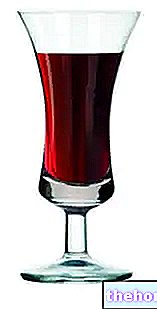What is the whiskey?
The whiskey (or whiskey) is a spirit of Anglo-Saxon origin.
It is a distillate produced from the fermentation of cereals (barley, corn, rye and wheat) or from the malt that can be obtained from it (especially barley).

Whiskey production is strictly regulated all over the world and the only ESSENTIAL requirements that the drink requires are 3: fermentation of cereals, distillation and aging in wooden barrels.
Nutritional Characteristics
Whiskey, like other spirits, is a drink that contains a wide range of flavoring substances; among these, 200 or 300 are easily detectable with simple chemical analysis. These flavorings include: carbonyl compounds, alcohols, carboxylic acids and their nitrogen or sulfur esters, tannins, other phenolic compounds, terpenes, oxygen-containing heterocyclic compounds and fatty acid esters. Nitrogen compounds include pyridines, methylpyridines and pyrazines.
Whiskey is a distillate with an alcoholic percentage that reaches 35-40% vol. It is therefore logical that (even in subjects without complications or pathologies) it is essential to consume it in at least modest portions, ie ≤ 40-80ml / day. From a nutritional point of view, whiskey provides ONLY some antioxidant molecules of a phenolic nature but, due to the high concentration of ethyl alcohol, these cannot be introduced in significant quantities.
The consumption of whiskey is therefore not recommended in the diet of healthy subjects and is particularly not recommended during growth, pregnancy and lactation. Furthermore, as it is logical to think, any abuse can be responsible for the onset of various diseases; then, if these disorders had a different etiology, whiskey would still be able to worsen the course.
Among the diseases involved (generated or compromised) by the abuse of whiskey (or other alcoholic beverages), some are of a metabolic nature (hypertension, hypertriglyceridemia, metabolic syndrome), while others of a toxic nature (on the tissues). blood alcohol levels are: the liver, kidneys, pancreas, prostate and brain.

Nutritional values (per 100 g of edible portion)
As if that were not enough, when the mucous membranes of the digestive tract are frequently exposed to alcohol, they can also suffer direct damage (esophagus, stomach and intestines). In practice, in addition to those already described, the excess of whiskey leads to worsening other intestinal disorders (eg Crohn's disease and ulcerative rectal colitis), increased sensitivity for subjects with irritable bowel and the appearance or aggravation of gastritis, gastric or duodenal ulcer, gastroesophageal reflux (more likely of onset of Barrett's esophagus). It goes without saying that the chronicization of some of these conditions can drastically increase the risk of certain types of cancer (especially of the stomach and esophagus).
It is also very important to remember that ethyl alcohol (therefore also whiskey itself) is responsible for both the reduction of intestinal absorption and the compromise of pharmacological metabolism.
For those who practice intense sport, the excess of whiskey can have three undesirable effects. The first concerns hydration, since alcohol causes an increase in urination with a greater tendency to body dehydration (already compromised by sweating for sports activities) . Secondly, drinking whiskey in the evening can significantly change sleep cycles, limiting sleep and impairing certain hormonal flows. Finally, remember that ethyl alcohol is a powerful hypoglycemic agent, which is why the consumption of whiskey before or after activity would be responsible for the deterioration of athletic performance and short-term recovery capacity.
NB. whiskey and other spirits are beverages potentially implicated in the onset of drug addiction.
Production and Aging
Whiskey is made from water, grains (or malt) and yeasts. Malt is obtained by drying by burning peat.
The whiskey processing processes are: maceration, fermentation, distillation, maturation, blending and bottling.
Aging lasts a few years (from 2 to 20) in wooden barrels, which can be of European or American oak (with about 1 century of age), previously used for the maturation of bourbon or sherry.
Types of Whiskey
The various types of whiskey differ in base substrate, alcohol content and quality.
- Malt whiskey: it is essentially produced with barley malt
- Grain whiskey: is made from whole grains
The types of malt and the various grains are combined in different ways to define certain types of whiskey:
- Single malt whiskey: produced by a single distillery that uses only one type of malt. Unless otherwise specified, it is the result of mixing liquids extracted from various barrels and vintages. It is possible that he uses special treatments (such as the use of port wine barrels)
- Blended malt whiskey: is a blend of single malt whiskeys from different distilleries. If labeled as "malt" or "pure malt", it is almost certainly a blend and is called "malt vatted"
- Blended: consists of a blend of different types of whiskey from many distilleries.
- Cask strength (also known as "barrel proof"): these are rather rare whiskeys and usually involve the finest drinks. They are bottled from barrel-aged whiskey NOT diluted or only partially diluted
- Single cask (also known as "single barrel"): these whiskeys are bottled from a "single cask and often the bottles are labeled with all the specifications. The taste of these whiskeys can vary greatly from cask to cask.
There are also many distinctions between the various whiskeys produced in various countries, but this is too complex a classification to mention in a single paragraph.
Etymology and Early History
The term whiskey (or whiskey) is the Anglicism of the Gaelic noun uisce/uisge, which means "water"; this derives from the fact that "ethyl alcohol, in Latin, was known as" water of life "(water vitae). The translation of "water vitae " in Irish Gaelic is "uisce beatha ", while in Scottish Gaelic it is "uisge beatha". The first forms of English translation were uske beaghe , usquebaugh , usquebauth And usquebae .
Today, the differentiation of the two nouns, whiskey and whiskey respectively, is still quite controversial. One school of thought argues that this is a casual distinction, induced by the writer's preference; the other specifies that the two words distinguish products based on the place of consumption. "Whiskey" would be the drink used in Canada, Japan, Scotland, England and Wales, while "whiskey" is more common in Ireland and the United States d "America; however, this distinction is not always well defined.
"Scotch" is the internationally recognized term for "Scotch Whiskey".
The Scottish and Irish art of commercial distillation dates back to about the 15th century AD, parallel to that of Central European brandy for medicinal purposes. The first written record of whiskey production dates back to 1405, in Ireland, in which a death from poisoning is documented In Scotland, on the other hand, the first find dates back to 1494 and mentions a supply of malt by the King to a friar, with the order to produce about 500 bottles of brandy.
The oldest whiskey distillery is there Old Bushmills Distillery, located in the north of Ireland (operational since 1608).
Other Alcoholic Alchermes Alcohol test Alcopops Cocktail Alcoholic Alcoholic units calculation Cognac Gin Grappa Alcoholic degree Grappa Limoncino Maraschino Marsala Nocino Prosecco Rum Rum Sherry Sparkling wine Spirits Wine Port wine Vermouth Vodka Vov Whiskey Categories Alcoholic foods Meat Cereals and derivatives Sweeteners Sweets Offal Dried fruit Milk and derivatives Legumes Oils and fats Fish and fishery products Cold cuts Spices Vegetables Health recipes Appetizers Bread, Pizza and Brioche First courses Second courses Vegetables and salads Sweets and desserts Ice creams and sorbets Syrups, liqueurs and grappas Basic preparations ---- In the kitchen with Leftovers Carnival recipes Christmas recipes Light diet recipes Women's, mom's and dad's day recipes Functional recipes International recipes Easter recipes Celiac recipes Diabetic recipes Holiday recipes Valentine's Day recipes Vegetarian recipes Protein recipes Regional recipes Vegan recipes




























